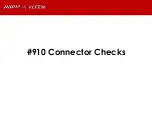
31
FINAL CHECKLIST
BEFORE RUNNING YOUR NEW XXX-T MF2 for the first time, you should run down the following checklist in order and
complete the listed tasks. I'm sure you're anxious to get out and run your new XXX-T MF2 now that it's built, but following this
simple checklist will help to make your first run with your new car much more enjoyable.
1. Adjust the differential
See: About The Differential, in the tips section.
2. Adjust the slipper
See: Adjusting The Slipper, in the tips section.
3. Check for free suspension movement
All suspension arms should move freely. Any binds will
cause the car to handle poorly. The steering should also
operate very freely.
4. Set the ride height
You should start with the rear ride height where the truck
comes to a rest at a height where the dogbones are slightly
below level with the surface. The front ride height should
be set so that the bottom of the chassis is level with the
surface.
5. Adjust the camber
Both front and rear tires should have 1/2 degree of nega-
tive camber (top of the tire leans in). It is critical that
both front and both rear tires be adjusted the same. With
either end of the car closest to you, use your assembly
wrench to adjust the tierods. Turn the top of the wrench
towards the center of the car to shorten the tierods, and
the opposite direction to lengthen them.
6. Set the front toe-in
Adjust the front tie rods so that, when the steering is
straight on the transmitter, the front tires are both point-
ing straight. It is recommended that you start with the
front toe-in set to zero (no toe-in or toe-out).
7. Charge a battery pack
Charge a battery pack as per battery manufacturer's and/
or charger manufacturer's instructions so that
radio adjustments can be made.
8. Adjust the speed control
Following the manufacturer's instructions, adjust your
speed control, and set the throttle trim on your transmit-
ter so the the car does not creep forward when not apply-
ing throttle. Make sure that there is not too much brake
being applied when the trigger/stick is in the neutral po-
sition.
9. Set transmitter steering trim
The steering trim tab on the transmitter should be ad-
justed so that the car rolls straight when you are not touch-
ing the steering wheel/stick. If the servo was installed
correctly, as per Tables 52A and 52B, the wheels should
turn equally to the left and right. If this is not the case,
refer to Figure 55 A,B,C, and ensure that the steering
servo and rod were properly installed.
TIPS AND HINTS FROM THE TEAM
About The Differential Never allow the diff to slip; that’s what the slipper is for. Before trying to adjust your diff, you need to
tighten the slipper until the spring is fully compressed. Next, hold the spur gear and right rear tire, then try turning the left rear
tire forward or backwards. It should be very difficult to turn the left rear tire. If the tire turns easily, the diff is too loose. To
tighten the diff, line up the slot in the diff screw with the groove in the left outdrive. Place the 1/16” Allen wrench through both
of these slots. This will lock the diff screw and the outdrive together. While holding the Allen wrench in place, turn the right rear
tire forward about 1/8 of a turn. Check the differential adjustment again and repeat the tightening process as necessary until the
differential is no longer slipping. See "Adjusting the Slipper" on the following page, and then continue from here. The final
differential adjustment check should be made by placing the car on carpet, grass, or asphalt and punching the throttle. The
differential should not slip (slipping produces a "barking" sound). If it does, tighten the diff in 1/8-turn increments as described
above until the slippage stops.
Once the diff has been adjusted, it should still operate freely and feel smooth. If the diff screw starts to get tight before the
diff is close to being adjusted properly, the diff should be disassembled and inspected; you may have a problem with the differ-
ential assembly. Refer to the assembly instructions to ensure that the diff is properly assembled and that all parts are properly
seated in the assembly.
There are a few things you should know about differentials. First, when rebuilding your diff, you should always replace the
small, diff nut. Second, after the diff has been run a time or two, it is not uncommon for the balls to seat into the rings and create
a slightly loose adjustment. So, after your first and second runs, check the adjustment to avoid slippage. Third, remember: Never
let the diff slip. Doing so can damage the diff balls, rings, and gear. Always make sure that the slipper will slip before the diff.








































